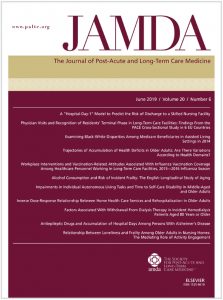Publications

Managing Paratonia in Persons With Dementia: Short-termEffects of Supporting Cushions and Harmonic Techniques
Authors: Bieke Van Deun, Nele Van Den Noortgate, Anke Van Bladel, Koen De Weerdt, Dirk Cambier
Affiliations: Department of Rehabilitation Sciences and Physiotherapy, Ghent University; Department of Geriatrics, Ghent University Hospital, Ghent, Belgium
Journal: Journal of the American Medical Directors Association - December 2019, Volume 20, Issue 12, Pages 1521-1528 (DOI: 10.1016/j.jamda.2019.04.031)
-
Field & Applications:
- Medical
- Clinical trial
- Neurology
- Neurodegenerative disorder
- Gerontology / Ageing
Objectives: Paratonia, a form of hypertonia typically seen in dementia, is often associated with difficulties in positioning and daily care. No evidence-based therapy or clinical guideline for management is available. In this study, the short-term effect of harmonic techniques (HT) and supporting cushions (SC) on paratonia was explored.
Design: This was a multicenter interventional clinical trial with AB/BA crossover design. Each intervention (SC or HT) was subsequently implemented over 1 week in each of the participants.
Setting and participants: The study included 22 participants with moderate to severe paratonia from 9 different nursing homes in Flanders, Belgium.
Methods: Measurements of biceps brachii and rectus femoris muscle tone (MyotonPRO), maximal elbow and knee extension (goniometer), and pain (Pain Assessment Checklist for Seniors With Limited Ability to Communicate) were performed on 3 different days within 1 week. The effect of HT on nursing care was evaluated with the Pain Assessment Checklist for Seniors With Limited Ability to Communicate and visual analog scale ratings of discomfort items.
Results: After 30 minutes of positioning with SC, participants had lower biceps brachii muscle tone (P = .041) and higher maximal elbow extension (P = .006) than without SC. After a 30-minute session of HT, a significant increase in biceps brachii muscle tone (P = .032) and maximal extension of elbow (P < .001) and knee (P = .028) was found. Pain (P = .003) and discomfort (P = .001 to P = .019) during morning care were significantly lower when care was preceded by 30 minutes of HT.
Implications: This explorative study revealed beneficial short-term effects on range of motion for both SC and HT and a positive effect of SC on upper limb muscle tone. Beneficial effects of HT were found on resident’s pain and caregiver’s discomfort during care. The results of the present study are encouraging and can contribute to the development of evidence-based interventions for paratonia.
This explorative study revealed beneficial short-term effects on the range of motion for both supporting cushions and harmonic techniques, and supporting cushions had an additional positive effect on upper limb muscle tone. A small but significant beneficial effect of harmonic techniques was shown on residents’ pain and caregivers’ discomfort during care. These encouraging findings should be further confirmed, and the long-term effects of supporting cushions and harmonic techniques should be investigated in future studies. Nevertheless, the results of the present study are a promising step toward the development of evidence-based interventions for paratonia.


